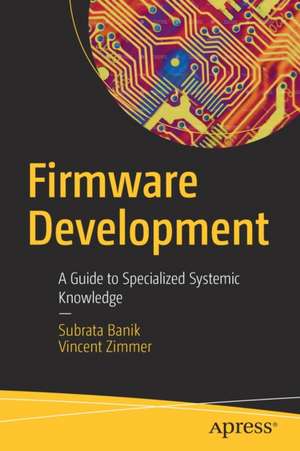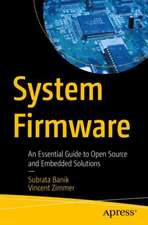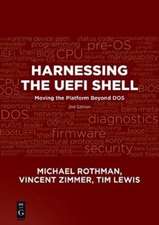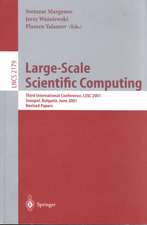Firmware Development: A Guide to Specialized Systemic Knowledge
Autor Subrata Banik, Vincent Zimmeren Limba Engleză Paperback – 29 sep 2022
After reading the book you will be able to assume better control while developing your own firmware and know how to interact with native hardware while debugging. You will understand key principles for future firmware development using newer technology, and be ready for the introduction of modern safe programming languages for firmware development. Detailed system firmware development case studies using a futuristic approach cover:
- Future scalable system firmware development models
- Types of firmware development (system firmware, device firmware, manageability firmware)
- Tools and their usage while creating system firmware
- How to build infrastructure for seamless firmware development using a multi-party development model
- Debugging methodologies used during various phases of firmware product development
- Setting up key expectations for future firmware, including thinner firmware footprints and faster execution time, easier configuration, and increased transparent security
What You Will Learn
- Understand the system firmware working model of the future
- Gain knowledge to say goodbye to proprietary firmware for different types of firmware development
- Know the different types of tools required for creating firmware source code before flashing the final image into the boot device of the embedded system
- Develop skills to understand the failure in firmware or in the system and prepare the debugging environment to root cause the defects
- Discern the platform minimal security requirement
- Optimize the system firmware boot time based on the target hardware requirement
- Comprehend the product development cycle using open source firmware development
Who This Book Is For
Embedded firmware and software engineers migrating the product development from closed source firmware to open source firmware for product adaptation needs as well as engineers working for open source firmware development. A secondary audience includes engineers working on various bootloaders such as open source firmware, UEFI, and Slim Bootloader development, as well as undergraduate and graduate students working on developing firmware skill sets.
Preț: 308.76 lei
Preț vechi: 385.96 lei
-20% Nou
Puncte Express: 463
Preț estimativ în valută:
59.10€ • 64.22$ • 49.68£
59.10€ • 64.22$ • 49.68£
Carte disponibilă
Livrare economică 31 martie-14 aprilie
Preluare comenzi: 021 569.72.76
Specificații
ISBN-13: 9781484279731
ISBN-10: 1484279735
Pagini: 398
Ilustrații: XXXIII, 398 p. 134 illus., 106 illus. in color.
Dimensiuni: 155 x 235 mm
Greutate: 0.61 kg
Ediția:1st ed.
Editura: Apress
Colecția Apress
Locul publicării:Berkeley, CA, United States
ISBN-10: 1484279735
Pagini: 398
Ilustrații: XXXIII, 398 p. 134 illus., 106 illus. in color.
Dimensiuni: 155 x 235 mm
Greutate: 0.61 kg
Ediția:1st ed.
Editura: Apress
Colecția Apress
Locul publicării:Berkeley, CA, United States
Cuprins
Chapter 1: Spotlight on Future Firmware.- Chapter 2: Tools.- Chapter 3: Infrastructure for Building Your Own System Firmware.- Chapter 4: System Firmware Debugging.- Chapter 5: Security in its Core.- Chapter 6: Looking into the Future of System Firmware.- Appendix A: Evolution of System Programming Language.- Appendix B: initramfs: Call for Type-Safe Language.
Notă biografică
Subrata Banik is a Firmware Engineer with more than a decade being spent in the computer industry and acquired experiences in system firmware design, development and debugging across various firmware architectures like UEFI, coreboot, Slim bootloader etc. for x86 and ARM platforms. Subrata has profound experience on platform enablement that leads into working for all the leading PC-makers’ products. Subrata is an active member of open-source firmware (OSF) development across different projects like coreboot, oreboot, flashrom, EDKII etc., where he is one of the leading contributors in the open firmware (coreboot) development. Subrata has received multiple US Patents and is very passionate about learning new technology and sharing knowledge among enthusiast engineers. Subrata has presented his technical talks at industry events such as Open Source Firmware conference, Institute for Security and Technology, Intel Developer Forum etc.
When not writing or working, he can be found enjoying watching sports (especially football) or spending time with his daughter. A fun fact about Subrata is, he is a strong believer of Time travel existence.
Vincent Zimmer has been working on embedded firmware for the last 30 years. Vincent has contributed to or created firmware spanning various firmware initiatives, including the Extensible Firmware Interface, where Vincent presently leads the Security subteam in the UEFI Forum. Vincent has also co-authored various papers and books, along with being a named co-inventor on over 450 US patents.
When not writing or working, he can be found enjoying watching sports (especially football) or spending time with his daughter. A fun fact about Subrata is, he is a strong believer of Time travel existence.
Vincent Zimmer has been working on embedded firmware for the last 30 years. Vincent has contributed to or created firmware spanning various firmware initiatives, including the Extensible Firmware Interface, where Vincent presently leads the Security subteam in the UEFI Forum. Vincent has also co-authored various papers and books, along with being a named co-inventor on over 450 US patents.
Textul de pe ultima copertă
Build your own system firmware. This book helps you understand system firmware architecture and minimalistic design, and provides a specialized knowledge of firmware development.
The book includes guidance on understanding the system firmware build procedure, integrating pieces of firmware and allowing configuration, updating system firmware, creating a development infrastructure for allowing multi-party collaboration in firmware development, and gaining advanced system firmware debugging knowledge.
After reading the book you will be able to assume better control while developing your own firmware and know how to interact with native hardware while debugging. You will understand key principles for future firmware development using newer technology, and be ready for the introduction of modern safe programming languages for firmware development. Detailed system firmware development case studies using a futuristic approach cover:
After reading the book you will be able to assume better control while developing your own firmware and know how to interact with native hardware while debugging. You will understand key principles for future firmware development using newer technology, and be ready for the introduction of modern safe programming languages for firmware development. Detailed system firmware development case studies using a futuristic approach cover:
- Future scalable system firmware developmentmodels
- Types of firmware development (system firmware, device firmware, manageability firmware)
- Tools and their usage while creating system firmware
- How to build infrastructure for seamless firmware development using a multi-party development model
- Debugging methodologies used during various phases of firmware product development
- Setting up key expectations for future firmware, including thinner firmware footprints and faster execution time, easier configuration, and increased transparent security
- Understand the system firmware working model of the future
- Gain knowledge to say goodbye to proprietary firmware for different types of firmware development
- Know the different types of tools required for creating firmware source code before flashing the final image into the boot device of the embedded system
- Develop skills to understand thefailure in firmware or in the system and prepare the debugging environment to root cause the defects
- Discern the platform minimal security requirement
- Optimize the system firmware boot time based on the target hardware requirement
- Comprehend the product development cycle using open source firmware development
Caracteristici
Explains how to use Git, Gerrit, and GitHub Teaches the debugging tools and methodology used by industry-leading vendors Shows how to create adaptive open firmware solutions with optimized boot time and space constraints



























